About Project
February 19, 2010, in the Alexander Palace of Tsarskoye Selo a press conference devoted to the beginning of the project took place. The State Museum «Tsarskoye Selo» heads O. Taratynova, I. Bott, as well as an artist S. Pchelnikova participated in the conference.

On the same day, Svetlana Pchelnikova donated a copy of the bear Alfonso owned by Princess Xenia Georgievna Romanova to the museum.

The organiser of the project Svetlana Pchelnikova had a unique research task. It’s known that in 1923, the collection was moved to Sergiev Posad and became the fundamental part of the toy Museum. At the moment it includes 1500 items (dolls, table and sports games, mechanical toys, lotto games, doll clothing and other accessories). Due to the nature of this extremely fragile collection, she practically NEVER leaves the museum walls.
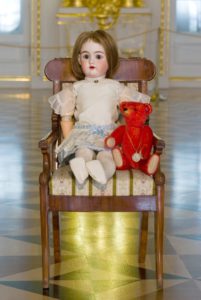
The artwork on the reconstruction of the toys started with a preliminary research work. Through photos, drawings, references in the memoirs of the noblemen of that time the lost items belonged to children of the last Russian Emperor have been recreated.
In a preliminary period, experts gave special consultations about tissues, specific features of the fine art collections of that time. Old dollmaking techniques of the late XIX-early XX centuries were studied.
The research results allowed to reproduce the atmosphere in which the children of Nicholas II grew with the utmost precision. And the highest evaluation of this work is that now the collection of imperial dolls occupies a worthy place in the exposition of one of the best museums of the country — the State Museum- ‘Tsarskoe Selo’.
The initiators of the project worked in three main areas:
- Reconstruction of the collection, the search and recreation of the authentic dolls and toys by the best doll masters and restorers.
- Making copies of the famous ancient dolls and toys found in the collections of the historical museums.
- Work with antique dolls collectors to create a temporary exhibition especially for the 300-year anniversary.
At the same time organisers worked with private collectors to create a temporary exhibition and celebrate the 300-year anniversary.
In summer 2010 in Tsarskoe Selo the exhibition of the first part of the restored collection was opened to the public. Dolls and toys were presented to viewers in one of the newly renovated halls of the Alexander Palace. At that very time, Tsarskoe Selo was the centre of the celebration of its 300th anniversary.
For the exhibition grand opening, several antique dolls of the late nineteenth-early twentieth century were prepared. Svetlana Pchelnikova had found and transferred those dolls from European countries specifically for the project. This search was done together with the restoration work. It’s difficult to imagine the scope of the search! It was made in a dozen places around Europe, surveying the territory. Contacts were established both with the official art institutions (museums, archives), and the owners of private collections in European countries. Many dolls of the world famous German firms such as Armand Marseille, Kammer&Reinhardt, Simon& Halbig and Kestner were found. Early period dolls by French S. F. B. J also represented the age. All these brands made dolls for almost all nursery rooms of noble European houses of the time. Also, a rare automaton by the French company Leopold Lambert with the head made by the firm Simon & Halbig was found. Very similar doll, but in another suit, was used in the Royal nursery and now it is kept in the Toy Museum in Sergiev Posad. Svetlana Pchelnikova found the Kodak Brownie camera made in 1913. Every member of the Royal family used a camera of the same type, and even girls successfully coped with it. The other unique item found by the team was a book named «Puss In The Boots» written in English and illustrated by Walter Crane. The same edition was presented to the Grand duchesses Olga and Tatiana on Christmas day 1900. Items found by Svetlana became a sufficient part of the restored collection of dolls and toys of the Tsar’s children in the Alexander Palace.
It’s necessary to note that at the IX International Doll Salon Svetlana Pchelnikova has donated the results of her work to the museum. This action shows not only her artistic maturity but also a high level of citizenship and patriotism. The collection includes 13 dolls, over 100 items of interior decorations and doll clothing. A few items of the collection are modern replicas of the dolls of the eighteenth century. They were restored using a very limited information, but it is known that the Grand Duchess and girls from the noble families of the late eighteenth century played with very similar dolls.
Among the most valuable items, we can name two antique dolls.
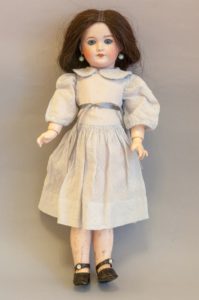
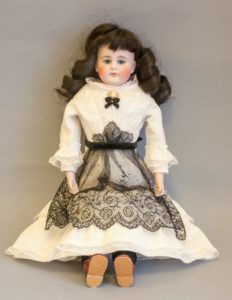
One doll with long black hair wears a blue-grey cotton dress and black shoes (France, firm «SFBJ» [«Society for French manufacturers of dolls and toys»], 1900-is). The second wears a long white Batiste dress trimmed with lace and a black lace apron. She uses a lush black wig [Germany, firm «Kestner»], 1860-1890 years). Doll made by these firms used to be at Nursery rooms of the Alexander Palace.

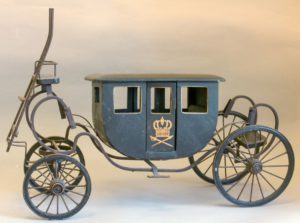
A modern replica of the old black carriage has the door decorated with the Prussian crown, made presumably in Germany in the second half of the twentieth century. The carriage and a doll tricycle donated to the Museum have represented the collection of toys of the Tsar’s Village for the first time.
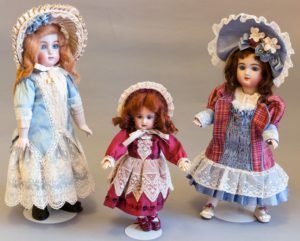
Three replicas of antique dolls of the late XIX-early XX century also are given to The Museum. The most important is the small doll called «Bebe Fleur» made by the company «Daniel Ko» (a modern copy of 1890 original). It has a porcelain head with blue eyes, a wig of dark brown mohair, a silk dress with jacquard red, dark blue and cream shades, trimmed with white lace, a straw hat trimmed with silk and lace. The other two dolls are a doll «Bebe Sonnenberg» and the “Premier of Bluet”. They are decorated differently, as Bebe has a porcelain head and blue eyes; she wears a wig of Golden mohair. The doll is dressed in a gown of white, blue and cream silk, trimmed with vintage lace, a hat with silk flowers and lace. The Premier of Bluet doll has dark blue glass eyes, silk dress, purple-red hue with antique lace and blue silk hat with white lace and flowers. Both dolls are the authentic replicas of the originals made in 1895 and 1905.
The collection is enriched with a pair of antique lace gloves for a girl and a No. 8 French fashion magazine «La mode illustrée» (25 February 1872). A very interesting item is a coloured print from No. 1 fashion magazine «La mode illustrée» (1870). The children’s book «Our menagerie» (the «Firefly», 1906), a collection of children’s and doll clothes are now included in the collection.
Among the donated items are dolls made by well-known companies from Germany and France, that were very popular at the beginning of XX century. Such dolls were possible to find in the rooms of young Grand princesses in Alexander Palace.
Thanks to the hard work done by Svetlana Pchelnikova, the impressive results are achieved.

Currently, the collection occupies a worthy place in the Museum of Tsarskoe Selo, attracting the attention of both adults and children. However, artistic research work continues. Svetlana Pchelnikova has motivated her colleagues to participate in the project. Now the reconstruction of the cultural environment through children toys continues.
Svetlana Pchelnikova’s contribution to the history of our culture is very important. Now we can understand aesthetic principles of children education in Russia more than one century ago.